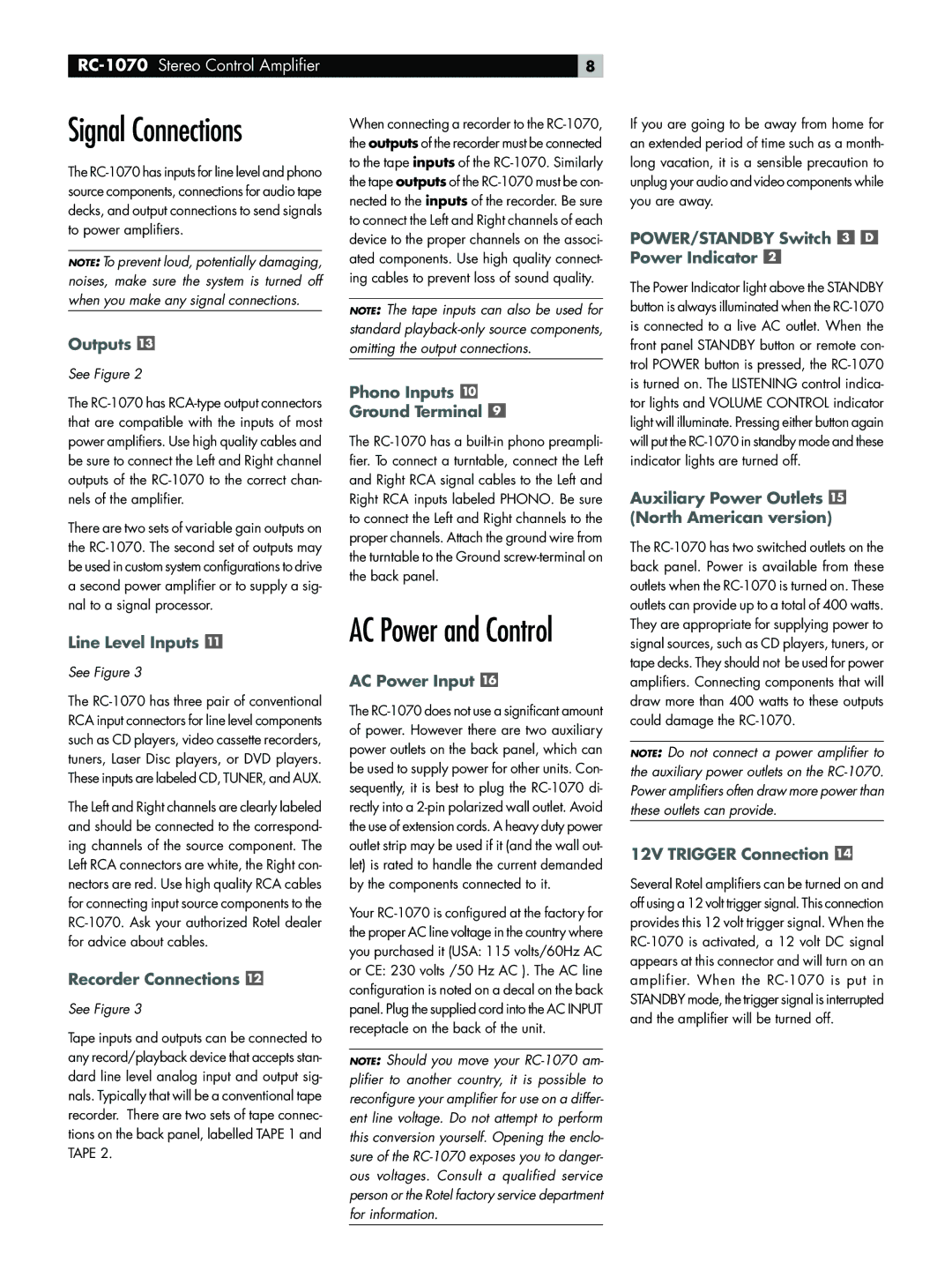RC-1070Stereo Control Amplifier
Signal Connections
The RC-1070 has inputs for line level and phono source components, connections for audio tape decks, and output connections to send signals to power amplifiers.
NOTE: To prevent loud, potentially damaging, noises, make sure the system is turned off when you make any signal connections.
Outputs 
See Figure 2
The RC-1070 has RCA-type output connectors that are compatible with the inputs of most power amplifiers. Use high quality cables and be sure to connect the Left and Right channel outputs of the RC-1070 to the correct chan- nels of the amplifier.
There are two sets of variable gain outputs on the RC-1070. The second set of outputs may be used in custom system configurations to drive a second power amplifier or to supply a sig- nal to a signal processor.
Line Level Inputs 
See Figure 3
The RC-1070 has three pair of conventional RCA input connectors for line level components such as CD players, video cassette recorders, tuners, Laser Disc players, or DVD players. These inputs are labeled CD, TUNER, and AUX.
The Left and Right channels are clearly labeled and should be connected to the correspond- ing channels of the source component. The Left RCA connectors are white, the Right con- nectors are red. Use high quality RCA cables for connecting input source components to the RC-1070. Ask your authorized Rotel dealer for advice about cables.
Recorder Connections 
See Figure 3
Tape inputs and outputs can be connected to any record/playback device that accepts stan- dard line level analog input and output sig- nals. Typically that will be a conventional tape recorder. There are two sets of tape connec- tions on the back panel, labelled TAPE 1 and TAPE 2.
8
When connecting a recorder to the RC-1070, the outputs of the recorder must be connected to the tape inputs of the RC-1070. Similarly the tape outputs of the RC-1070 must be con- nected to the inputs of the recorder. Be sure to connect the Left and Right channels of each device to the proper channels on the associ- ated components. Use high quality connect- ing cables to prevent loss of sound quality.
NOTE: The tape inputs can also be used for standard playback-only source components, omitting the output connections.
Phono Inputs 
Ground Terminal 
The RC-1070 has a built-in phono preampli- fier. To connect a turntable, connect the Left and Right RCA signal cables to the Left and Right RCA inputs labeled PHONO. Be sure to connect the Left and Right channels to the proper channels. Attach the ground wire from the turntable to the Ground screw-terminal on the back panel.
AC Power and Control
AC Power Input 
The RC-1070 does not use a significant amount of power. However there are two auxiliary power outlets on the back panel, which can be used to supply power for other units. Con- sequently, it is best to plug the RC-1070 di- rectly into a 2-pin polarized wall outlet. Avoid the use of extension cords. A heavy duty power outlet strip may be used if it (and the wall out- let) is rated to handle the current demanded by the components connected to it.
Your RC-1070 is configured at the factory for the proper AC line voltage in the country where you purchased it (USA: 115 volts/60Hz AC or CE: 230 volts /50 Hz AC ). The AC line configuration is noted on a decal on the back panel. Plug the supplied cord into the AC INPUT receptacle on the back of the unit.
NOTE: Should you move your RC-1070 am- plifier to another country, it is possible to reconfigure your amplifier for use on a differ- ent line voltage. Do not attempt to perform this conversion yourself. Opening the enclo- sure of the RC-1070 exposes you to danger- ous voltages. Consult a qualified service person or the Rotel factory service department for information.
If you are going to be away from home for an extended period of time such as a month- long vacation, it is a sensible precaution to unplug your audio and video components while you are away.
POWER/STANDBY Switch 
 Power Indicator
Power Indicator 
The Power Indicator light above the STANDBY button is always illuminated when the RC-1070 is connected to a live AC outlet. When the front panel STANDBY button or remote con- trol POWER button is pressed, the RC-1070 is turned on. The LISTENING control indica- tor lights and VOLUME CONTROL indicator light will illuminate. Pressing either button again will put the RC-1070 in standby mode and these indicator lights are turned off.
Auxiliary Power Outlets  (North American version)
(North American version)
The RC-1070 has two switched outlets on the back panel. Power is available from these outlets when the RC-1070 is turned on. These outlets can provide up to a total of 400 watts. They are appropriate for supplying power to signal sources, such as CD players, tuners, or tape decks. They should not be used for power amplifiers. Connecting components that will draw more than 400 watts to these outputs could damage the RC-1070.
NOTE: Do not connect a power amplifier to the auxiliary power outlets on the RC-1070. Power amplifiers often draw more power than these outlets can provide.
12V TRIGGER Connection 
Several Rotel amplifiers can be turned on and off using a 12 volt trigger signal. This connection provides this 12 volt trigger signal. When the RC-1070 is activated, a 12 volt DC signal appears at this connector and will turn on an amplifier. When the RC-1070 is put in STANDBY mode, the trigger signal is interrupted and the amplifier will be turned off.

